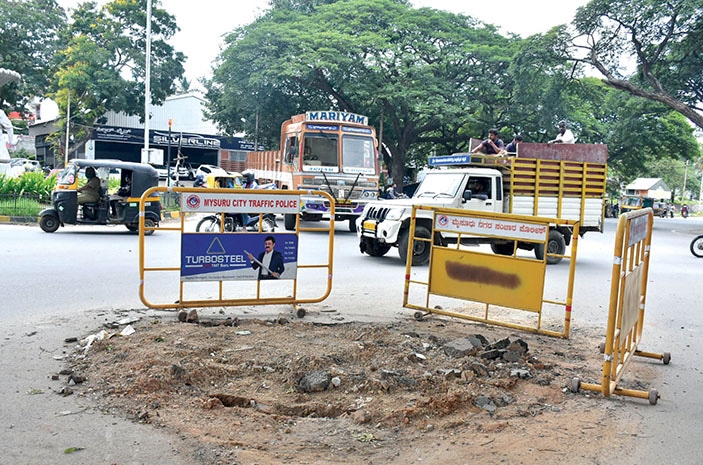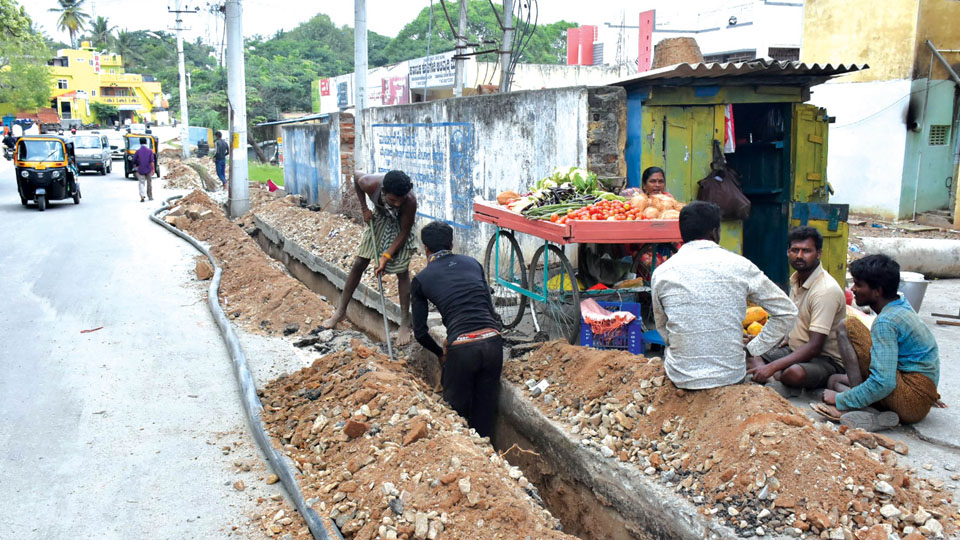Cable-laying in full swing at Jodi Thenginamara Road, Medar Block, Yadavagiri and Manjunathapura
Mysore/Mysuru: The Chamundeshwari Electricity Supply Corporation (CESC) that has taken up a massive project of converting overhead power lines into underground power cables has completed 50 percent of first phase of works. At present, the project is being implemented in N.R. Sub-Division. The first phase is estimated to cost the Corporation Rs. 300 crore.
It is an approximate Rs. 600 crore project being undertaken by the State Energy Department and CESC, Asian Fab Tec Limited (AFTL), Larsen & Toubro (L&T) are the implementing and supervising authorities.
The CESC has chosen to lay underground cables to prevent any damages caused to overhead power lines due to trees falling during rains and gusty winds. The first phase of the project covers over 500 kilometres of areas and the major part of the work is toad drilling and digging in four sub-divisions –– Hootagalli, N.R. Mohalla, Kuvempunagar and City Centre.
Now digging and cable-laying works are under progress in the surroundings of Jodi Thenginamara Road, Medar Block, Yadavagiri and Manjunathapura. N.R. Sub-Division (UGC Project), CESC Executive Engineer Doddamani is in charge of the works and CESC Assistant Executive Engineer Surendra is supervising the works.

Combination of wires
The wires are a combination of High Tension (HT) 11 KV line and Low Tension (LT) line that supplies power to houses. The LT line carries 440 volts of power and as part of the works, feeder Pillar Boxes are installed on the roadsides and these boxes will supply power to 8 to 9 houses. Each box has control points and if there is a problem in the main 11 KV line, the Control Point next to the line trips and the issue is identified and set right.
Overhead cables hanging precariously low pose grave threat to residents and livestock. Many people have already died after being electrocuted by suspended high-tension wires. Underground cables eliminate this threat. Though underground cable project is more expensive than aerial bunching of cables, underground cables will help improve reliability in power supply, reduce the number of accidents caused by overhead wires, and improve the aesthetics of the city,” CESC officials said.
Stage-by-stage process
CESC had started the massive project in two phases last year. The works were taken up in a stage-by-stage process with the focus on the Central Zone in the Central Business District — Mysore Palace, Rama Vilas Road, Hardinge Circle, City and Sub-urban Bus Stations, Double Road, K.R. Circle, D. Devaraj Urs Road, Doddakere Maidan, Deputy Commissioner’s Office, Zilla Panchayat Office and surrounding areas.
After the road is drilled by Horizontal Direction and Drilling Machine and pits are dug up manually, the power cables are laid and drawn from one end to another. From here, connections are provided to a cluster of homes and shops in any given area, engineers explained.
The progress of the cable-laying works came to a standstill due to COVID-19-induced lockdown for over five months. CESC had already paid Rs. 14 crore to the Mysuru City Corporation (MCC) to dig parts of the road to lay the cables.








Recent Comments